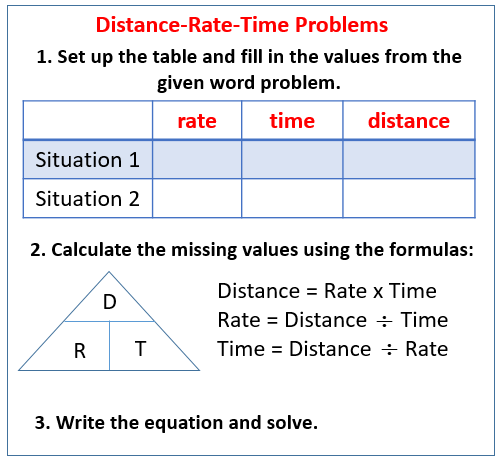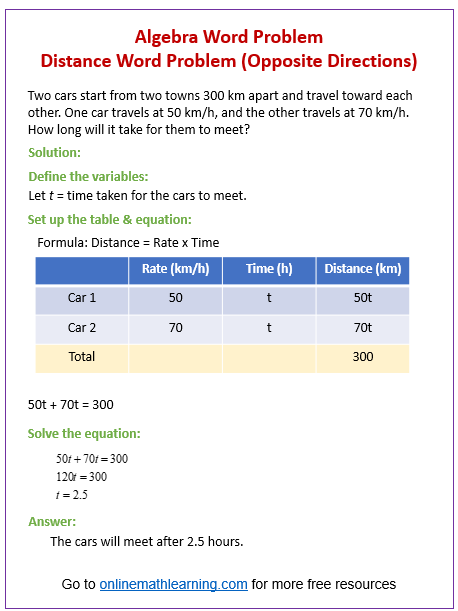Rate Distance Time Problems (Opposite Directions)
Related Pages
Rate, Time, Distance - Algebra Word Problems
Distance Problems
Distance Word Problems
Average Speed Problems
In these lessons, we will learn how to solve rate time distance word problems where the objects are traveling in opposite directions. You may be required to find the time when the objects meet or the time when the objects are a certain distance apart.
Distance problems are word problems that involve the distance an object will travel at a certain average rate for a given period of time.
The formula for distance problems is: distance = rate × time or d = r × t.
It would be helpful to use a table to organize the information for distance problems. Make sure that your units are consistent.
The following diagrams give the steps to solve Rate Time Distance Word Problems. Scroll down the page for examples and solutions.

The following diagram gives the steps to solve a Distance-Rate-Time Problem involving two objects going in opposite directions.

Key Idea for Opposite Direction Problems:
- Total Distance: The sum of the distances traveled by each object equals the initial distance between them (if they are moving towards each other) or the final distance between them (if they are moving away).
Types of Distance Word Problems:
Travel in Same Direction
Travel in Opposite Directions
Round Trip Problems
Average Speed Problems
Wind/Current Problems
Printable & Online Algebra Worksheets
Distance Problems: Traveling In Opposite Directions
Example:
A bus and a car leave the same place and traveled in opposite directions. If the bus is
traveling at 50 mph and the car is traveling at 55 mph, in how many hours will they be 210 miles apart?
Solution:
Step 1: Set up a rtd table.
| r | t | d | |
|---|---|---|---|
| bus | |||
| car |
Step 2: Fill in the table with information given in the question.
If the bus is traveling at 50 mph and the car is traveling at 55 mph, in how many hours will they be 210 miles apart?
Let t = time when they are 210 miles apart.
| r | t | d | |
|---|---|---|---|
| bus | 50 | t | |
| car | 55 | t |
Step 3: Fill in the values for d using the formula d = rt
| r | t | d | |
|---|---|---|---|
| bus | 50 | t | 50t |
| car | 55 | t | 55t |
Step 4: Since the total distance is 210, we get the equation:
50t + 55t = 210
105t = 210
Isolate variable t
![]()
Answer: They will be 210 miles apart in 2 hours.
Example of a distance word problem with vehicles moving in opposite directions
In this video, you will learn to solve introductory distance or motion word problems - for example, cars traveling in opposite directions, bikers traveling toward each other, or one plane overtaking another. You should first draw a diagram to represent the relationship between the distances involved in the problem, then set up a chart based on the formula rate times time = distance.
The chart is then used to set up the equation.
Example:
Two cars leave from the same place at the same time and travel in opposite directions. One car
travels at 55 mph and the other at 75 mph. After how many hours will they be 520 miles apart?
Rate-Time-Distance Problem
Solve this word problem using uniform motion rt = d formula:
Example:
Two cyclists start at the same corner and ride in opposite directions. One cyclist rides twice as
fast as the other. In 3 hours, they are 81 miles apart. Find the rate of each cyclist.
Distance - Opposite Directions
Example:
Brian and Jennifer both leave the convention at the same time traveling in opposite directions.
Brian drove at 35 mph and Jennifer drove at 50 mph. After how much time were they 340 miles apart?
Distance - Opposite Directions find t
Example:
Two joggers start from opposite ends of an 8 mile course running towards each other. One
jogger is running at a rate of 4 mph. The other is running at a rate of 6 mph. After how
long will the joggers meet?
Distance - Opposite Directions find r
Example:
Bob and Fred start from the same point and walk in opposite directions. Bob walks 2 mph faster
than Fred. After 3 hours they are 30 miles apart. How fast does each walk?
Check out many other Algebra Word Problems
Age Word Problems, Average Word Problems, Coin Word Problems, Consecutive Integer Word Problems, Digit Word Problems, Distance Word Problems, Fraction Word Problems, Geometry Word Problems, Integer Word Problems, Interest Word Problems, Lever Word Problems, Mixture Word Problems, Money Word Problems, Motion & Distance Word Problems, Number Sequence Word Problems, Proportion Word Problems, Quadratic Equation Word Problems, Ratio Word Problems, Symbol Word Problems, Variation Word Problems, Work Word Problems.
Try out our new and fun Fraction Concoction Game.
Add and subtract fractions to make exciting fraction concoctions following a recipe. There are four levels of difficulty: Easy, medium, hard and insane. Practice the basics of fraction addition and subtraction or challenge yourself with the insane level.

We welcome your feedback, comments and questions about this site or page. Please submit your feedback or enquiries via our Feedback page.